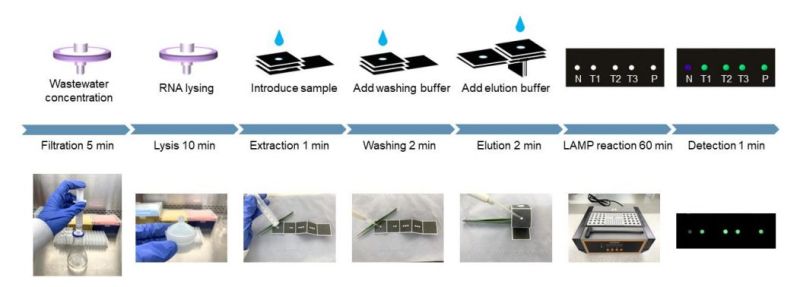
Wastewater sampling has become a popular way over the years to keep track of the health of a population, including human ones, as pathogens are often detectable in the effluence from toilets. Since most houses connected to the centralized sewer systems, this means that a few sampling sites suffice to keep tabs on which viruses are circulating in an area. While sampling this wastewater is easy, the actual RNA analysis using PCR (polymerase chain reaction) still has to be performed in laboratories, adding complex logistics. An approach for on-site analysis using microfluidics was tested out by [Yuwei Pan] et al., as recently published in Cell.
This particular approach uses RT-LAMP (reverse-transcription loop-mediated isothermal amplification) to increase the amount of genetic material, which has the significant benefit over PCR that it does not require multiple thermal cycles, instead being run at a constant temperature. The filter paper used as the basis has wax microchannels printed on it, which help to guide the filtered wastewater to the reaction chambers. This is in many ways reminiscent of the all too familiar linear flow self-tests (RAT: rapid antigen test) that have become one of the hallmarks of the SARS-CoV-2 pandemic.
What this paper microfluidic device adds is that it doesn’t merely contain antigens, but performs the lysis (i.e. breakdown of the virus particles), genetic material multiplication using RT-LAMP and subsequent presence detection of certain RNA sequences to ascertain the presence of specific viruses. Having been used in the field already since 2020 in the UK, the researchers envision this type of on-site analysis to be combined with a smartphone for instant recording and transmission to health authorities.
Some of the benefits of this approach would be lower cost, easier logistics and faster results compared to shipping wastewater samples to central laboratories.















PCR can have a very high false positive rate, often it can be too sensitive to be useful. The designers of this will need to be very careful in terms of the number of amplification cycles they use, lest they find that whatever they are looking for is absolutely everywhere at all times.
Also the existing systems give a count instead of a yes/no which is useful for showing trends.
The official changes to this number of cycles and when they happened can be very illustrative.
No, no it can’t. This is a pretty common conspiracy trope that came out of covid. You can’t amplify something that is not there